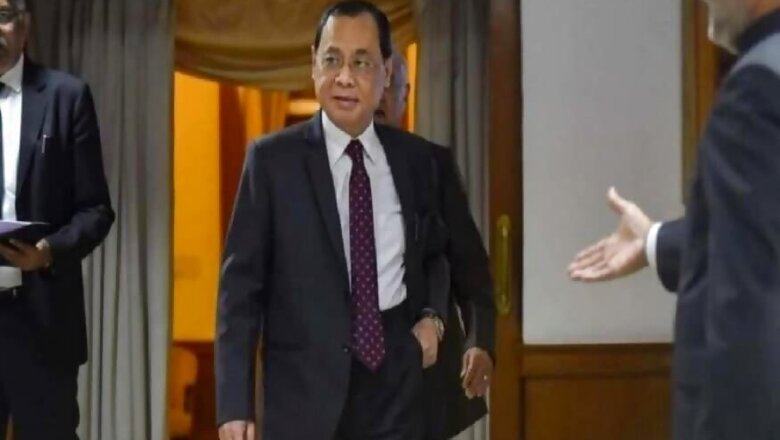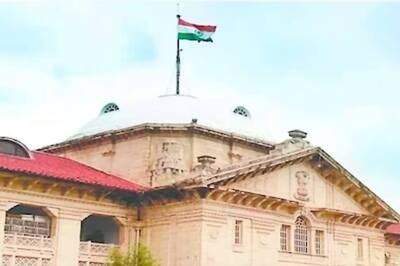
views
Former Chief Justice of India Ranjan Gogoi’s nomination to the Rajya Sabha, his speech in Parliament and television interviews have generated considerable discussion. Earlier, former CJI Ranganath Mishra was a Rajya Sabha member, winning the election on a Congress ticket seven years after retirement. Advocate Baharul Islam too was elected to the Rajya Sabha on a Congress ticket who but he resigned later and became a judge in the Gauhati High Court.
A section of opinion shared in the media states that Gogoi’s nomination to the Rajya Sabha will break the Code of Omerta that prevented judges from talking about corruption and loss of independence. Who are we fooling by saying so and on whose behest? In 2010, former law minister Shanti Bhushan moved an application in the Supreme Court, accusing eight former CJIs of corruption. He also wrote that two former Chief Justices told him while they were in office, their immediate predecessor and immediate successor were corrupt judges. Names of these four CJIs were also mentioned in the application.
In 2015, former SC judge Markandey Katju told a gathering of Punjab & Haryana High Court lawyers that 50% of the higher judiciary (SC and HC judges) was corrupt. In April 2017, a CJI-headed SC bench summoned Justice CS Karnan of Kolkata High Court in contempt of court, and Karnan in turn summoned the CJI and six other SC judges to appear at his residence. Karnan did appear before the SC later but reiterated his charges against the CJI and six SC judges. Karnan was finally retired but the sordid drama uncovered the state of morality and conduct in higher echelons of the judiciary.
In January 2017, the Bar Council of India informed the apex court that its ‘ongoing’ pan-India drive found the number of 'genuine lawyers' was just about 55-60%. So, how many ‘non-genuine’ lawyers became judges over the years? There was also a CD circulating in 2012 of a politician putting a prospective judge through a personal physical, filmed by his driver. Post-retirement employment of judges in tribunals, commissions or other assignments has been ongoing for years. Whether and how such promises do or do not affect judgments is for the readers to discern.
Vague judgments which help governments of the day also have been practised in the past several days. Same goes for post-retirement judicial assignments but in this case anything not palatable to the government of the day can be muzzled. Report of the one-man judicial committee of L Narasimha Reddy, former Chief Justice of Patna High Court, on OROP is in the freezer since October 26, 2016 though it was a 10-month sojourn for Reddy visiting 20 cities/towns, enjoying hospitality of the army and multiple states, at the end of which he thanked the powers for enabling his char dham yatra in style.
The revelation by Gogoi about a lobby influencing the judiciary is nothing new except that he put the number at half a dozen. It boils down to corruption and integrity of judges, same as what Shanti Bhushan wrote to the SC and Markandey Katju told lawyers of Punjab & Haryana High Court. How is judiciary held to ransom – money, fear of life, career progression or ‘promises’ of post- retirement employment? If judiciary was or is being controlled, what about bodies like the Election Commission of India and Comptroller and Auditor General that are supposed to be constitutionally protected?
January 12, 2018 witnessed an unprecedented spectacle of four senior SC judges, including Ranjan Gogoi, publicly protesting against the CJI and holding a joint press conference about problems they said were afflicting the functioning of the top court. Did such open protest befit senior judges of SC or was it better for them to jointly meet the Prime Minister or the President and brief them about the problems or irregularities in the SC? Given the lobby/controller theory, are we in for more such public protests? What about decorum of the SC?
Many judgments in high-profile cases were given during Gogoi’s tenure as CJI which are well known. But isn’t it surprising that the plea to open inquiry into ethnic cleansing of Kashmiri Pandits from the Valley was not entertained on the grounds that the case was too old? Was this due to pressure from the lobby/controllers/government? Can Gogoi throw some light on how his work was interfered with and how did he clean house? How come the SC didn’t take suo-moto notice of former Jammu and Kashmir chief minister Farooq Abdullah allegedly publicly preaching secession and demanding imposition of Sharia even before abrogation of Article 370?
Discussion over how soon a Chief Justice or CJI should be inducted in Parliament post retirement only results in mudslinging. Every government rules the roost and does what it wants. Induction of Gogoi into the Rajya Sabha is very good especially with many in Parliament, even ministers, making fools of themselves periodically on electronic media through nonsensical statements. Gogoi says he was looking forward to enjoying a retired life till he received the call (on behalf of the President) about nomination to the Rajya Sabha, which he could not refuse. This is akin to the former Chief of the army Staff (COAS) saying he was looking forward to retired life, probably running a school, knowing fully he was to be the first Chief of Defence Staff (CDS). Gogoi would have been sounded in advance about his nomination: standard procedure in all such cases.
Assam is an important state, what with the turbulence on account of the National Register of Citizens and Citizenship Amendment Act related protests that caused cancellation of the Modi-Abe annual summit at Guwahati last year. Post signing of the New Bodo Accord, Prime Minister Modi visited Assam on February 7 to a tumultuous welcome and addressed a massive rally at Kokrajhar. Gogoi’s inclination for politics would have been gauged by the government—usefulness as an asset with Assam going to polls next year. Hence the strategy to ‘tap him’ through nomination to the Rajya Sabha and ‘fix’ him through the grilling on Republic TV, where he looked uncomfortable, obviating possibility of him switching to another party. We may see a bigger political role for Gogoi in future — in Assam, in the Union Cabinet, or even as Vice President.
Finally, it is about the lobby/controllers, referred to by some as the 'Lutyens' Gang'. But tentacles of India’s ‘deep state’ are spread pan-India and its core holds every the government to ransom – refer to the Vohra Committee Report of 1993. Where the media has been branding someone as the most corrupt politician in the country, how is he back in Parliament, even heading an important standing committee, after a brief detention? Obviously we lack the will to demolish the core and only scratch the surface periodically for political brownie points.
(The author is an Indian Army veteran. Views are personal)




















Comments
0 comment